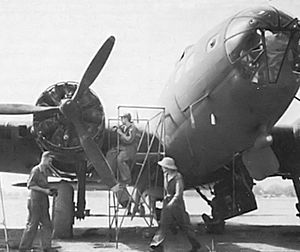14th Bombardment Squadron
| 14th Bombardment Squadron | |
|---|---|

14th Bombardment Squadron B-17E, Clark Field, Philippines before the 8 December 1941 attack
|
|
| Active | 1917–1946 (Not equipped or manned, May 1942 – April 2, 1946) |
| Country | United States |
| Branch | United States Army Air Forces |
| Role | Bombardment |
| Part of | Far East Air Force |
| Engagements |
World War II Battle of the Philippines |
| Insignia | |
| 14th Bombardment Squadron emblem |  |
The 14th Bombardment Squadron is an inactive United States Air Force unit. The 14th Bomb Squadron fought in the Battle of the Philippines (1941–42), much of its aircraft being destroyed in combat against the Japanese. The survivors of the ground echelon fought as infantry during Battle of Bataan and after their surrender, were subjected to the Bataan Death March, although some did escape to Australia. The remainder of the air echelon fought in the Dutch East Indies campaign (1942) before being reassigned to other units. The squadron was never remanned or equipped. It was carried as an active unit until April 2, 1946.
Operated as a flying training unit, 1917–1918.
Operated from Bolling Field, DC, 1928–1935. A C-2A transport of the squadron participated as the receiving aircraft ("Question Mark") in a week-long endurance flight testing the practicability of aerial refueling.
The 19th Bombardment Group had been selected for transfer to the Philippines; however, the need for B-17 bombers there was so urgent that a provisional group already in Hawaii was dispatched to Manila by way of Australia in September. Under the command of Maj Emmett O'Donnell, Jr., nine B-17s of the 14th Bombardment Squadron (Provisional),the nine crews made up of the cream of the 5th and 11th Bomb Groups, pioneered an air ferry route from Hawaii to the Philippines, leaving on September 5, 1941, and arriving on September 12, 1941, at Clark Field, Philippines. This was the first flight of land-based bombers across the central Pacific. A portion of the flight involved traversing uncharted waters from Wake Island to Port Moresby and Darwin and thence to Fort Stotsenburg. They maintained radio silence over the Japanese mandate islands. Successful completion of this historic flight proved that the Philippines could be reinforced by air. For extraordinary achievement in this flight, the airmen of this squadron were awarded the Distinguished Flying Cross. The squadron became part of the Philippine Department Air Force, which subsequently became the Far East Air Force on November 16, 1941, and was attached to the 19th Bombardment Group (Heavy).
...
Wikipedia
